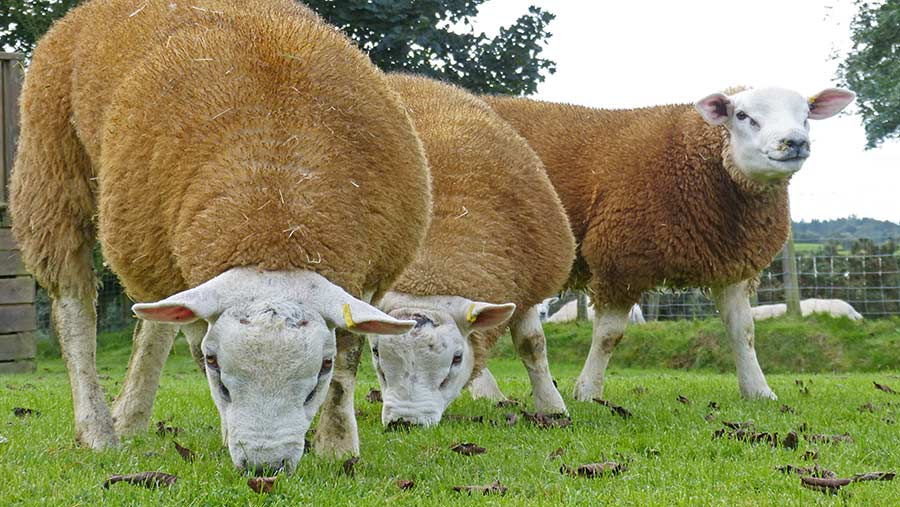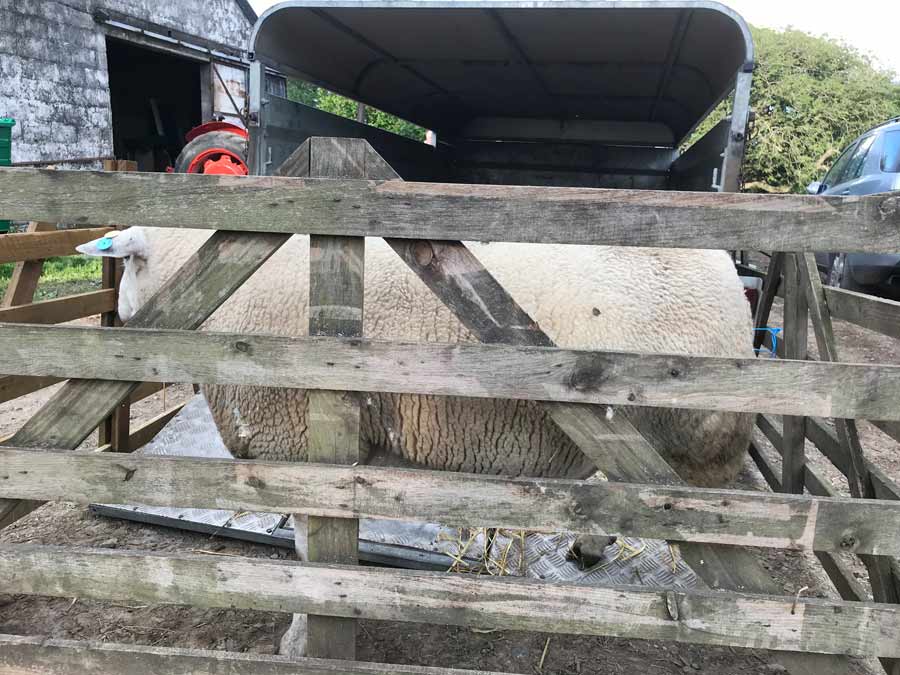How Ram Compare could add £5 to lamb value

A national terminal sire sheep evaluation project has identified rams that can finish faster and at better grades on nine commercial sheep farms across the UK.
Over the past four years, the Ram Compare project has used flock and carcass data to find sires that can add up to £5 to lamb value or cut seven days off slaughter age.
By analysing a range of carcass traits and using computerised tomography (CT) scanning, the scheme is finding rams that produce progeny of greater value.
This is according to Signet manager Samuel Boon, who is involved in the data collection and analysis.
See also: Texel tup breeder works towards forage-only system
He stressed that lambs reared on the nine farms were all from commercially focused, forage-based finishing systems.
All flocks and progeny were put through the same data-collection protocol, seeing ewes weighed and condition scored and lambs assessed through their lives and after slaughter.
Which rams came out on top?
Results of the third year of Ram Compare can be found on the Signet website.
Rams are ranked for primal yield, scan weight, muscle depth, shear force, fat depth, carcass weight, carcass conformation, fat class, days to slaughter and overall carcass merit.
Addressing a Ram Compare event at the Hutts Farm, Grewelthorpe, North Yorkshire, Mr Boon reminded breeders that all Signet evaluations are now weight-adjusted and more relevant for commercial producers (see “Why estimated breeding values are better’).
“Ram Compare shows that choosing rams on scan weight, muscle depth and fat depth can increase the proportion of carcasses hitting specification and reduce days to slaughter,” said Mr Boon.
He added that estimated breeding values (EBVs) that were drawing on abattoir data and CT scanning were making genetic rates of gain even faster.
£3-£5 a head more
Mr Boon said high-index terminal sire rams in the test were producing finished lambs that were £3-£5 a head more valuable than those produced by stock rams.
This was due to superior performance in key carcass traits such as muscle depth, fat class and eye muscle area of the loin.
Ram Compare is using single-sire mating and detailed carcass analysis and performance recording to learn about the performance and heritability of performance-recorded terminal sires.
Why EBVs are better than before
-
Monthly analysis Evaluations are now multi-breed and done monthly.
-
Weight-adjusted traits Rather than being adjusted for age, traits are now adjusted for weight, which is more relevant for breeders aiming for a level of finish and fat cover at a commercial weight, rather than selecting lambs on their age. Previously, a high-muscle depth sheep could have been large, or a sheep with good muscle depth relative to its size.
-
Four new carcass traits Intramuscular fat percentage, the UK’s first meat-eating quality EBV, spine length, eye muscle area.
-
Three new lambing traits Birth weight, lambing ease, litter size reared.
-
Rebasing All EBVs and indexes have been rebased to 2010, meaning EBVs reflect the genetic gain across all breeds of livestock.
Rams used in Ram Compare 2019
- Beltex (natural and AI)
- Texel
- Meatlinc
- Hampshire Down
- Charollais
- Suffolk
Case study: May lambing forage system sees £3-£4 difference in rams
An organic late-lambing flock has seen the value of high-index terminal sires after two years’ involvement with the Ram Compare project.
Farm facts
- 202ha split, with 101ha on two sites
- 380 North of England Mules and 68 cross-bred suckler cows bred to AI and Angus and Salers stock bulls
- 30ha of arable 97ha of permanent pasture
- Organic farm in mid-tier stewardship
- Most land in tenanted agreements
- Biomass boiler
- Lambs sold deadweight to Dunbia
A comparison of two sires used across the flock of 380 North of England Mules of the Exelby family at The Hutts Farm, Grewelthorpe, North Yorkshire, revealed a benefit of £3.14 a lamb last year.

The Exelbys are using a Meatlinc as well as Charollais and Texel and Hampshire Down and Beltex and Suffolk tups
When two Charollais sires went head to head in 2018, the high-index ram produced vastly superior lambs (see “Charollais sires comparison”) that:
- Were worth £3.15 more a head (£77.79 v £74.64)
- Graded entirely at U- and R-grade on the Europ grid
- Weighed average of 19.5kg compared with the farm average of 19kg and average of 18.8kg for the stock ram
Charollais sires comparison |
|||
|
Ram |
U-grade |
R-grade |
O-grade |
|
Stock ram |
10% |
79% |
10% |
|
Lowerye Stallone |
62% |
38% |
– |
The key EBV that differentiated the two rams was muscle depth. Stallone had a muscle depth value of 3.42 (92% accuracy) compared with the stock ram, which had a muscle depth EBV of 0.64 (95% accuracy).
There was a negligible difference in days to slaughter between the two rams.
Breeder reaction
Mark Exelby is a big believer in flock data and performance figures.
He stresses the figures generated by Signet are vital to identify the better rams. “Stood in a pen with them, I can’t honestly tell how lambs will grade,” he admits.
“It’s only when we get the data and they’re hung up that you understand. It shows just how hard it is to pick out the best or worst ram by eye, but with data, you start to see patterns and stock that work for your farm.”
Breeder system
The farm runs two separate holdings, with The Hutts Farm in Nidderdale acting as a breeding unit, and a lowland farm at Gatenby, Leeming Bar, as a finishing unit.
Weaned calves and lambs are sent to the Gatenby Farm, where the Exelbys have more arable land and finish everything on forage.
Cattle are fed organic peas, barley and clover silages and lambs are rotationally grazed on red clover silage aftermath and mixed herbal leys, alongside oats through a three-in-one feeder.
The Exelbys buy running lambs from an organic farm near Windermere, Cumbria, to tup as shearlings.
Tupping takes place in December, leaving sheep to lamb outdoors in the kinder May weather.
Mastitis isn’t usually a problem, with the Exelbys having to cull five or six sheep each year for mastitis, although this year it rose to 25 because blowfly has been a problem.
The flock EID system is used to find underperforming sheep. The farm has found foot-rot vaccines work very well.
Ewes get two trace element boluses just before tupping and lambing and lambs are bolused at eight weeks to address selenium deficiency and ensure they have the trace elements required to optimise growth.
Lambs are weaned at 10 weeks old, this year averaging 29kg and last year were sold between 130-290 days, with 90% sold by Christmas.
Some AI work is carried out on tups to provide “genetic linkage” across the nine farms, which allows the Signet team to account for environmental variation across the farms.
This year the Exelbys are using a Beltex in AI on a sponge and synchronisation programme using frozen semen. They have been told to expect 50-60% conception rates, but have managed 80% so far.
